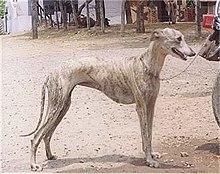Rampur Hound

Rampur Greyhound
|
|
| Other names | North-Indian Greyhound Rampur Hound |
|---|---|
| Origin | India |
| Domestic dog (''Canis lupus familiaris) | |
The Rampur Greyhound is a breed of dog native to the Rampur region of Northern India, which lies between Delhi and Bareilly. The Rampur hound is a large member of the sighthound family. In North West of India it is often described as a smooth-haired sighthound that is substantially built. It was the favored hound of the Maharajahs for jackal control, but was also used to hunt lions, tigers, leopards, and panthers. It was considered a test of courage for a single hound to take down a golden jackal. The Rampur is built to cover great distances at high speed but is also capable of great endurance.
Four commemorative postage stamps were issued on 9 January 2005 by India Post for four breeds (sic.) i.e. Himalayan Sheep Dog, Rampur Hound, Mudhol Hound (Face value Rs. 5.00 each) and Rajapalayam (Face value Rs. 15.00)
The length from the withers to the base of the tail is about 36 inches, with a chest which is deep but not very wide across the shoulders, and with well-sprung ribs. The tail is long and tapering slightly curving upwards and carried low; it is about 24"–27" in length. The neck, about 12 inches in circumference, is long, arched, and muscular, and rather broad where it joins the body. The roughly 9-inch-long jaws are expected to exhibit a powerful scissor bite. The males measure 60–75 cm (24–30 in) in height. The females measure 55–60 cm (22–24 in) in height. They weigh about 27–30 kg (60–65 lb).
They are approximately the same height as most other greyhounds, but much wider and more muscular, somewhat similar to the Rhodesian Ridgeback. The head of the Rampur is broader and more substantial than the head of the English Greyhound. It has a flat skull and a pointed nose. It also has a characteristic roman bend. Their ears are high-set on their head and held in a rose or pendant fashion. The Rampur's foot is a large "hare" shape, with heavy webbing. Their toes are very articulated and flexible, even able to bend backwards a bit. They are not unlike our own fingers in many ways. This maneuverability helps to give them a cat-like balance, with most dogs able to walk on ledges or to calmly clear a six-foot fence. Colors include mouse-gray, grizzle, brindle, particolor or, rarely, black. The gray and grizzle colorings in particular have the ability to blend particularly well with forest foliage, capable of making the dogs difficult to spot from a distance of as little as ten feet, in broad daylight. Black, however, is the most sought-after color of dog by many enthusiasts. Their eye color ranges from yellow to golden-brown.
...
Wikipedia
